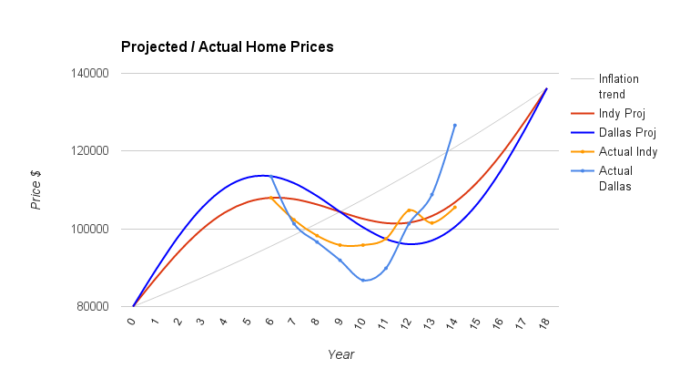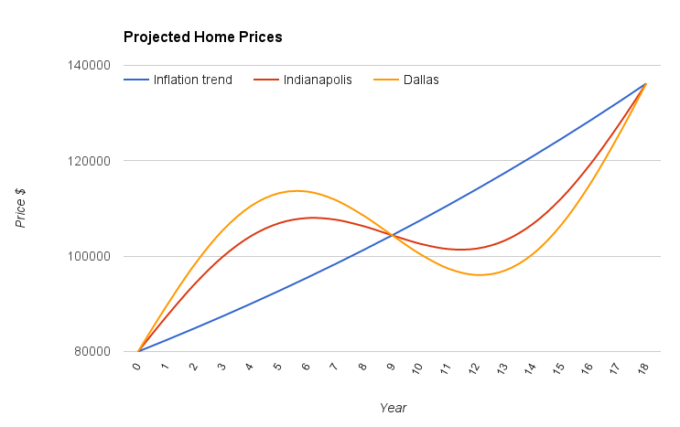The internet is a dangerous place to ask for advice.
There are a lot of haters our there – trolls – who spew negativity because their life is miserable.
Yet everyone I’ve encountered on personal finance blogs is very accepting and the comment sections are full of positivity. There are people who offer help if you need help and it can be a weight off your shoulders knowing that you’re not alone with particular problems. My guess is anyone who takes the time to better themselves by reading stuff like this is just a little more awesome.
So I’m seeking your opinion on a not too hypothetical situation.
Imagine This…
These aren’t my numbers, but let’s go through this as a thought exercise. You have:
- $20k car loan, 5 years at 3%
- $50k student loan, 15 years at 6%
- $100k rental property mortgage, 25 years at 5%
After a fitful night of sleep, you wake up grumpy and blame it on your lumpy mattress. Why is it so lumpy? In an uncharacteristic fit of anger you punch the mattress. To your surprise, it feels like something is inside …
Not wanting a dead animal in there, you decide to cut it open with the best tool you have in your apartment: a kitchen knife.
The battle is long and messy, but eventually you make a hole big enough to peer in. It’s too dark to see anything and you are scared to just reach in. So you take out your iPhone, turn on the flash light, and finally get a glimpse.
$20k in cash is all yours.
What do you do with it?
Oh the Possibilities
Let’s quickly rule out blowing the money on an extended vacation. You want to use this to get ahead financially.
What a coincidence, your car loan balance is exactly $20k. Maybe you should just pay that off in full?
But the student loan is the highest interest rate – maybe the $20k should be put towards that?
You are also a rental property investor and that is exactly the down payment for another single family home. With a 20 year time horizon, you are confident you can make a 20% yearly return.
What is the right move?
People Face a Similar Decision all the Time
Many people with student loans are also contributing to retirement accounts. They are facing a similar decision with every paycheck – should I pay down my loan that is at 6% or contribute to my 401k with a tax advantaged projected 8% return?
If you run the math, it says to use low rate loans to your advantage. Rather than paying off a 3% car loan, you are better off putting that money to use anywhere else.
Obvious side note – that doesn’t mean it is a good idea to go get as expensive a car as possible to have a large loan. Let’s say the example above was actually two dependable $10k used cars, not one brand new car. You want a car that will get the job done and also to put your money to work.
Borrowing Money is Not Inherently Evil
Credit card debt is absolutely horrible. However, it is something that people can find help to get out of; the services of CreditAssociates are an example of the forms of debt relief that are available to people in such situations. About a third of Americans carry a balance and pay an extreme 20% interest on their borrowing. To make it worse, too often the money is used with very little thought to buy crap they don’t need. However, others are genuinely in need of money to help them out of a rut and that could require some flexible borrowing. A solution to this could be using a title loan (https://www.thenetlender.com) to help them acquire the necessary funds they need to get by – it involves utilizing the money tied up in your existing vehicle.
Credit card debt can seriously affect someone’s credit score and they may find that they can’t lend money when they need to as they have numerous debts against there name. There are specifically designed credit cards for no credit so if someone desperately needs a credit card, they do have a lifeline.
This hatred of credit card debt is extended to other areas as well. Rather than evaluating each situation on its merits, many are lazy and extend this belief too far, not realizing the power of leverage through rental property investing – loans your tenant pays off for you.
So I Have a Car Loan…
Car loans are in fact bad debt. You are paying for something that is worth less as time passes. Compare that to a rental property, where you are paying for an asset that keeps going up in value. Obviously one is better than the other.
Despite know this, I just purchased a used car and took out 100% financing! Shocking right? What was I thinking?
First, I am capable of purchasing without taking the financing into account. Too many people purchase the nicest car their monthly payment will allow.
I also know I have the discipline to pay it off early if it is the best path. In fact, I can treat it as a 4 month loan and pay it off completely in one lump sum. I decided to pay a little bit for this option with wedding and honeymoon expenses these next couple months.
But I’m interested in hearing your thoughts.
What Do You Think?
1) How should the person who found $20k in the mattress use the money?
2) Should someone who is purchasing a car and has a student loan at 6% – pay in cash OR take out a 3% car loan to pay down the student loan faster?
3) Should someone who has a student loan at 6% and is able to save $1k per month – pay down their student loan OR contribute to a 401k.





